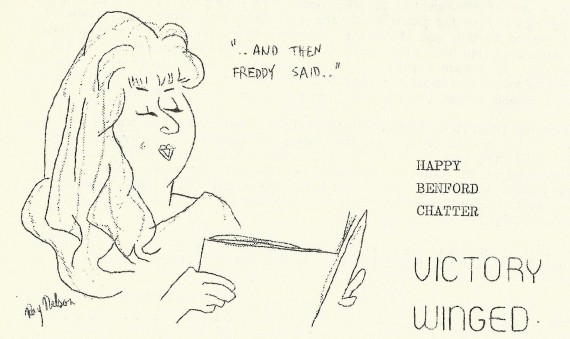
Fanzines reviewed: FRAP #2

Frap (#2) – Nov/Dec 1963
Faned: Bob Lichtman. American Genzine.
Seems like Robert Lichtman has been around forever. He is still active in FAPA (though no longer in the TePe Apa—that just expired) and still publishes fine and much sought-after annual editions of TRAPDOOR, an excellent genzine. Once a fan always a fan. FRAP is one of his earlier efforts (also of exceptional quality).
Bob begins by noting: “Present day fandom is not reflected accurately in the pages of FRAP to any great extent, because FRAP pays but lip-service to the main-streams of contemporary fannish thought, which are Serious Discussion and Comic Books…”
He then muses over the possibilities of composing a fannish version of Dicken’s A CHRISTMAS CAROL involving a BNF who
“employs a downtrodden but still essentially proud faanish fan, ‘Dean’ Cratchitt, to stencil and duplicate his focal point fanzine of discussion fandom.”
“…the Ghost of Fandom Past will hark back to the days of 1958 and 1959, when people mouthed their cigars like long-lost friends, when Bob Lichtman hadn’t known any fans for four years and more, and all like that.”
“Then the Ghost of Fandom Present will come on and cast an aura over the discussion and comic book phenomena, presenting pictures of fans dressed up like Superman and Donald Duck (the latter being daringly authentic by not wearing any pants), of discussion fans picketing stf conventions the committees of which have refused to take any political stands, of close-up scenes of people arguing over what fantasy world character they will dress up as this week, and of groups of people talking with each sentence ending in an exclamation point.”
“The Ghost of Fandom Future will come on finally and will reveal a Novum Fandom in which Konig has ceased to be self-conscious about faanish fandom… there are monthly VOIDS and FRAPS, and has an A BAS every year with each Derogation better than all its predecessors.”
“In the meantime, we are presented scenes of ‘Dean’ Cratchitt, and his wife, who is a femmefan, laboriously typing out master units for a faanish fanzine they manage to get out every two years or so, while their two young sons, Calvin and Andy Cratchitt, slowly turn out pages from these typed masters on a hectograph made of an old cookie pan.”
“In the end, of course, the discussion fan is so moved by the Three Ghosts of Fandom that he immediately becomes apolitical, folds his fanzine without refunding any money to the many subscribers, and, borrowing copies of A BAS, GRUE, FRAP and VOID for inspiration, turns into a faanish fan and writes heaps of choice material which Cratchitt publishes in his new monthly faanish fanzine, now mimeographed on the ex-discussion fan’s mimeo.”
Bob then concludes with “I thought I might write it up to put the readership of FRAP in the proper festive holiday mood, but then I decided not to, because this sort of thing is worth talking about at a party but not writing down.”
Hmmm. Costuming still very popular, though I suspect today most Superhero costumes are based on movie versions of old comic book heroes, with costumes based on comic book characters not as yet filmed being exceedingly rare, with the exception of Manga characters perhaps.
As for politics and serious discussion, these things come and go in fanzine fandom. I don’t think there is currently any great divide tearing fanzine fans into opposite camps. Most genzines these days are a mixture of everything, with personal musings at the forefront. Pretty much the way I prefer it, actually.
Next we come to a shocking – ‘shocking!’ I say – article on how Bob rid himself of an excess of fanzines.
“It was a magnificently huge collection… there were things in it of relatively little use to me such as three years of SAPS mailings, complete runs of crudzines… which I would never conceivably want to read ever again, but were there just because, goshwow, they were complete, By Ghod.”
“…something like this cannot go on forever unless you were Forrest J. Ackerman and have unlimited space for expansion in the form of an entire house plus garage… I periodically went about weeding out my collection…”
“At first this process consisted only of removing complete runs of magazines like YANDRO and SPACE CAGE, magazines which are of passing interest only when they come out… This practice put a considerable dent in my collection. However, since at the early stages… I tended to regard complete apa writings as being, somehow, sacrosanct and inviolable holy writings, the process was short-lived.”
“But it soon came to pass I needed a lot of that 20 feet of shelf space… one evening the whole pile of apa mailings got torn apart. I went through about eight feet or so of the combined output of five different apas, kept perhaps a foot of it, and carted the rest of it away. It is some sort of commentary on the quality of apa mailings that I kept approximately 10%.”
“Doubtless at this point the Collecting Fan has raised the hackles on his hack (whatever they are) and screamed, ‘Mighod, did he throw away that stuff?!!’”
“Of course not. I sold most of it. Some of the earlier stacks I gave away… but the later stacks and stacks of it, I sold at pretty good prices. A complete set of KIPPLE went for $3.00. A copy of WHY IS A FAN? In good condition went for $1.50. My complete set of XERO netted $10.00, almost complete profit. (I heard that at Washington some fan paid $28.00 for a similar set. These comic book fans! Where do they get the money?)”
“I made about $40.00 on the used fanzine market in one hell of a great big hurry and used it mostly at the Westercon. If I hadn’t sold all those fanzines, I still would have gone to the Westercon, but I wouldn’t have had as much fun. It is amazing the number of dinners and drinks you can net from a pile of junk SAPSzines.”
“This has been an essay on Selective Completism, of the gentle art of throwing out fanzines for fun and profit.”
I’ll have you know I resisted the temptation to run into my archive room and measure the footage of the shelving holding the BCSFA fanzine collection. But at 8,000 plus zines, I rather imagine it equals or surpasses Bob’s collection at the time of which he writes.
The BCSFA collection includes the zines I have purchased over the years. The bulk of the collection, however, consists of donations by fans undergoing “the process” Bob is writing about. At some point I will need to pass on the entire collection to an individual or organization willing to preserve them. If not someone in BCSFA or WCSFA, then? Time will reveal all.

Next, in a column titled VICTORY WINGED, Gregory Benford describes a conversation he had with Redd Boggs at a recent LASFS (Los Angeles Science Fantasy Society) meeting:
“You know,’ I said, ‘I think I know what it is that’s happening to some of the people in LASFS.”
“Yes?” said Redd Boggs.
“I have just now evolved a theory of dynamic history, Toynbee-like in its scope. These people may be the first example of retrograde evolution. How does the normal human being learn about reading? He works up from Dick and Jane, through more advanced Children’s books, through comic books and into mainstream literature of higher and higher degrees. When he’s about eleven or twelve he probably reads something like King Author and his Knights, and later maybe some Jules Verne or HG Wells. If he likes that sort of stuff he eventually works through juvenile stf to magazine fiction and the better stf novelists. It’s all a matter of development.”
“Well, yes,” said Redd Boggs.
“But have you noticed what happened in Los Angeles? A few years ago Coventry started getting popular. People began getting roles in it so they could act out their own parts. Bruce Pelz wore all-black clothes. And then everybody became interested in comic books. XERO came out. Comic book collections flourished. Fans started wearing comic book costumes. We had a panel discussion here on comic books not long ago, a whole meeting of it.”
“These people are working backwards. They’re starting at the top of literate development and backing down the slope, a little faster than they came up it.”
“Perhaps so, perhaps so,” said Redd Bobbs, nodding his head.
“But don’t you see what this means? We can take advantage of all this. These people pay money for their comic book collections—they’ll go to any extent to get what they want. And now we know what they’ll want next. We know which way they’ll jump. All we have to do is go round the old book stores and buy up first editions of Hardy Boys and Freddy the Pig books. They’ll be heavily in demand soon…”
“But at this point the meeting started and I didn’t get a chance to say any more.”
“I told Mr. Lichtman about this, but it did not strike him as a good idea.”
“How could I publish something like that?’ he said. ‘That’s all quite true, but it is also essentially cruel. Of course, we hate to see all that energy and talent wasted on trivial material, but this is too much. Don Fitch would frown on saying these things about such a large group of comparatively harmless people. It’s only a certain number in LASFS who are Coventry and comic book types, and they’re all comparatively recent arrivals, but they might take offense. If we can’t love them for their sores, let’s leave them alone.”
A gentle dig at fellow fen, a cunning faanish ploy, and a brilliant observational theory all in one article. Excellent!
I strongly suspect one of the amusing aspects of the above is Redd Boggs seemingly mindless acquiescence to what is being said. He had a reputation for ready wit and probably would have made somewhat more pointed comments than are revealed here.
“Coventry” requires a bit of explanation. Who better than Harry Warner Jr? I quote from his history of fifties fandom A WEALTH OF FABLE:
“One of the oddest subfandoms of the 1960s had its start in the previous decade. It was Coventry, invented in the 1950s by the youngsters living in and around Pasadena, California. They pretended that their city was the Mariposan Empire. This was an imaginary realm with water running along the streets, its nations bounded by blocks. Later, this make-believe became influenced by science fiction.”
“Inspiration came from Jame’s Blish’s novels about flying cities, the Krell race from the movie FORBIDDEN PLANET, and James Gunn’s novel THE IMMORTALS, with a contribution from Heinlein’s UNIVERSE. The name seems to have had no connection with events described in Heinlein’s celebrated COVENTRY.”
“Pasadena’s blocks were allowed to revert to exclusively mundane functions, and the renovated make-believe world was now a huge starship. Participants divided up among themselves the roles of the key people in this starship world. They developed gradually its history, they engaged in international intrigues and projects, they permitted some fantasy elements to be active in this science fiction concept, and by the end of the 1950s, the Coventry mania had spread to the LASFS, Orange County College, and Florida Speological Society.”
“Coventry began to assume increasing degrees of reality in the thinking of many participants. A few of them even thought seriously of utilizing drugs or hypnosis to plunge more deeply into the make-believe world. Some friendships shattered in disputes over continuing development of the fable. The decision of one participant to introduce lasers to Coventry seems to have been a particularly heretical episode.”
“Those who believed wholeheartedly in the value of Coventry said things like: ‘Coventry is not any more of a pretext for costume parties than the United States is an excuse for Caroline Kennedy to have a lawn to roll eggs on. It is a study of mankind.”
“Those who did not join the game said less respectful things, like the claim that the Coventry geography was actually molded on the grounds of the state insane asylum at Camarillo, or the description of Coventry as ‘Like Disneyland, only bigger.’ It was years before the fad vanished from fannish fen.”
And as for comics fandom, Harry Warner Jr. explained: “Comics fandom didn’t begin from just one episode. Before there was a subfandom on the topic, fanzines published an occasional item… Jack Speer… had spells when he went on and on in FAPA with essays about comics.”
“Phil Bronson… created in 1940 two issues of SCIENTICOMICS which might rank as the first false start of comics fandom. There were two issues of this hectographed octave publication which contained comic strips drawn in imitation of those in newspapers, but this project had little support and no progeny.”
“Much later, POGO, Walt Kelly’s character, created a small but ardent fandom… Lee Hoffman… was the fan who devoted the most space and time to Pogo, mixing the Possum’s world inextricably with fannish lore. She lived close enough to Okefenokee territory to be able to take bottles of swamp water to other Pogo admirers…”
“However, the real comics fandom… had its main beginnings completely independent of [SF] fandom… EC Comics… Bhob Stewart may have published the first EC fanzine, called the EC FAN BULLETIN. It survived only two issues, but imitators sprang up and soon were extolling other lines of comic books…”
“In 1960… Dick Lupoff published the first issue of XERO. It was not meant to be a comics fanzine, but it contained a nostalgic article about Captain Marvel. Suddenly more fans were confessing to lingering fondness in their early years for comic books. XERO also led indirectly to an epidemic of books about the comics from mundane professional presses, and helped to move along more briskly the entire trend toward nostalgia.”
“As the 1960s progressed, comics fans and science fiction fans found more common ground, although the under footing got quite shaky at times, and some conventions emphasised both the graphic and the linotype varieties of fantasy fiction.”
Hmm, a complete set of XERO netted Bob Lichtman $10.00 in 1963? Wonder what it would go for now?
And it should be noted, as Harry Warner Jr. concludes: “Also belonging… to the 1960s are the starts of subfandoms like the STAR TREK phenomenon, the Society for Creative Anachronism which was closely linked to fandom although its emphasis was on mundane medieval life, old radio fandom which collected and traded both fantasy and non-fantasy broadcasts, and games fandom which dealt with in-person and correspondence participation in various patented games.”
The 1960s a fecund decade indeed!
FRAP review to be continued next week.
P.S. “stf” = “scientifiction.”
P.PS. In case you are wondering, Harry Warner Jr. once gave me permission to quote any of his writings I liked. Seems he found my faaanish historian efforts worthwhile (though, of course, rather puny and pathetic compared to his—this being my observation, not his, I hasten to add).
BY THE WAY:
You can find a fantastic collection of zines at: Efanzines
You can find yet more zines at: Fanac Fan History Project
You can find a quite good selection of Canadian zines at: Canadian SF Fanzine Archive
And check out my brand new website devoted to my OBIR Magazine, which is entirely devoted to reviews of Canadian Speculative Fiction. Found at OBIR Magazine










